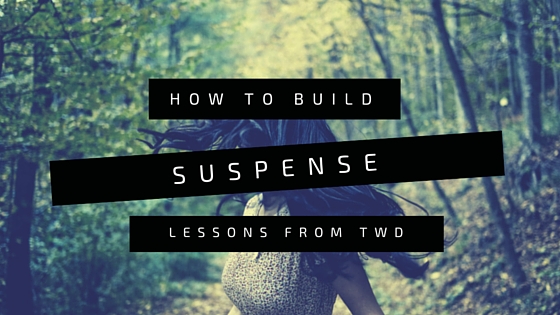How to Build Suspense: 5 Lessons from The Walking Dead
Whether it’s the mounting dread that any second now a zombie is going to jump out at you, or the pit in your stomach as tension builds between two characters and you know one of them is not making it out of this episode alive, if there’s one thing The Walking Dead does well, it’s build and maintain suspense.
But how do they do it?
Here are five effective tactics they use a lot that work really well.
NOTE: This post only contains spoilers through Season 3.
The Bomb Under the Table
In a now famous conversation with François Truffaut, Alfred Hitchcock said the difference between “surprise” and “suspense” is that surprise is when a bomb unexpectedly blows up from under a table, and suspense is when you see the bomber put it there.
A great example of this from The Walking Dead is in Season 3, Episode 13 when Rick and the Governor meet to discuss a possible truce. The Governor makes a big show of putting away his weapons and convinces Rick to do the same, but after sitting down, we see that the Governor has a gun taped under the table. This makes the scene much more suspenseful because as tensions rise in the room, we know that the Governor has a gun, and we know that Rick doesn’t know.
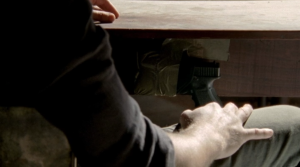
Several times during the scene, the Governor’s hand moves near where we know the gun to be and suspense builds – will he go for it? Similarly, there’s a moment when Rick lowers his guard and takes his eyes off the Governor for a moment. We want to shout at the screen, “Keep your eyes on him, Rick! He has a gun!”
The writers could instead have not shown us the gun but had the Governor suddenly pull it on Rick at an unexpected moment. This would have been surprising, but not suspenseful. We’d have spent the whole scene thinking the two were having a pleasant chat over whiskey and might have gotten bored.
On the other hand, they could have not shown the gun and not had the Governor pull the gun, but then shown after the scene was over that the gun had been there all along. That’s an interesting approach, but it would not have been as effective in this particular scene.
The Takeaway: Surprises can be great, but it doesn’t always have to be the audience that’s surprised. Sometimes the most suspenseful thing of all is when the audience knows something a character doesn’t.
The Silent Treatment
In several episodes through the series, the episode’s cold open (the part before the title credits) has no or almost no dialogue. Two examples are Season 3, Episode 1 (“Seed”) and Season 3, Episode 13 (“Arrow on the Doorpost”).
These scenes are incredibly suspenseful, even without the context of knowing where the characters are or what exactly they’re doing, and part of what makes it so tense is the lack of dialogue. We wonder why everyone is being so quiet – are they hiding from something?
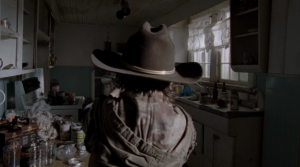
Also, the extreme quiet makes us think something very loud is about to happen. It’s not a bad guess.
The Takeaway: Not every scene needs dialogue. If you want to ratchet up the tension, try taking out the talking.
Everybody’s Right
If you break down the average episode of The Walking Dead, you’ll see that a large portion of the story is groups of characters in various combinations debating what to do about something. In a single episode you might have three separate debates raging between three different collections of characters. We rotate between these debates with episodes of zombie hunting (and other “fun” scenes) sprinkled in like seasoning.
What makes these debates interesting to watch is that in most cases, all of the characters are right. Or at least they’re partly right. Or they’re wrong, but you understand why they feel how they do and you wonder if you would feel the same in their shoes.
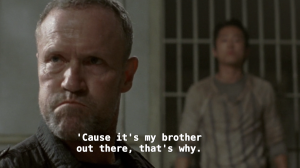
There are no easy answers and we can’t predict with certainty how things will end. The opposing sides of the debate set up two or more possible directions for the episode to take, like a Choose Your Own Adventure book you read as a kid.
We follow the debate like a tennis match as each side volleys its argument over the net, and the suspense comes from wondering who will finally win. Hint: sometimes when you win, you really lose.
The Takeaway: Show your audience two or more ways the story could go and have different characters lobby for each option. Make all the options equally bad, but give the characters good reasons for wanting what they do. Keep the audience on the edge of their seat wondering who will win, and what price they will pay for winning.
Somebody Screws Up
This is a situation where things are already tense, but then someone does something stupid – they make a noise when they were supposed to be quiet, they go outside without a weapon to check out a strange sound, etc. It adds suspense because it creates that classic horror movie trope where you scream at the TV: “DON’T GO IN THERE!”
This is a dangerous one because it’s wildly overused and can be frustrating for the audience when it isn’t earned. It works best in my opinion when two qualifications are met:
(1) the stupid thing the person does is surprising, and yet
(2) the stupid thing the person does is exactly what they would really do.
It doesn’t work, for example, for a kid whose constantly whining to start whining at the exact moment that the family is silently hiding from the killer. That’s annoying because it’s not surprising (the kid is always whining) and it’s also not super believable (they’re hiding from a killer). What does work is for the bratty kid’s toy he stole earlier and stuffed hurriedly in his pocket (but that you forgot he had) to suddenly roll out of his pocket in front of the killer’s feet. That’s surprising, but is also exactly the kind of stupid thing that kid would do.
A good example from The Walking Dead is from Season 3, Episode 14 (“Prey”). Andrea and Milton are talking about the Governor while standing in an open catwalk above his torture chamber when the Governor unexpectedly walks into the room below. Milton immediately hides, which is smart, but Andrea continues standing in the open, watching the Governor, where she’s in grave danger of being seen by him (which would likely result in him killing her and Milton).
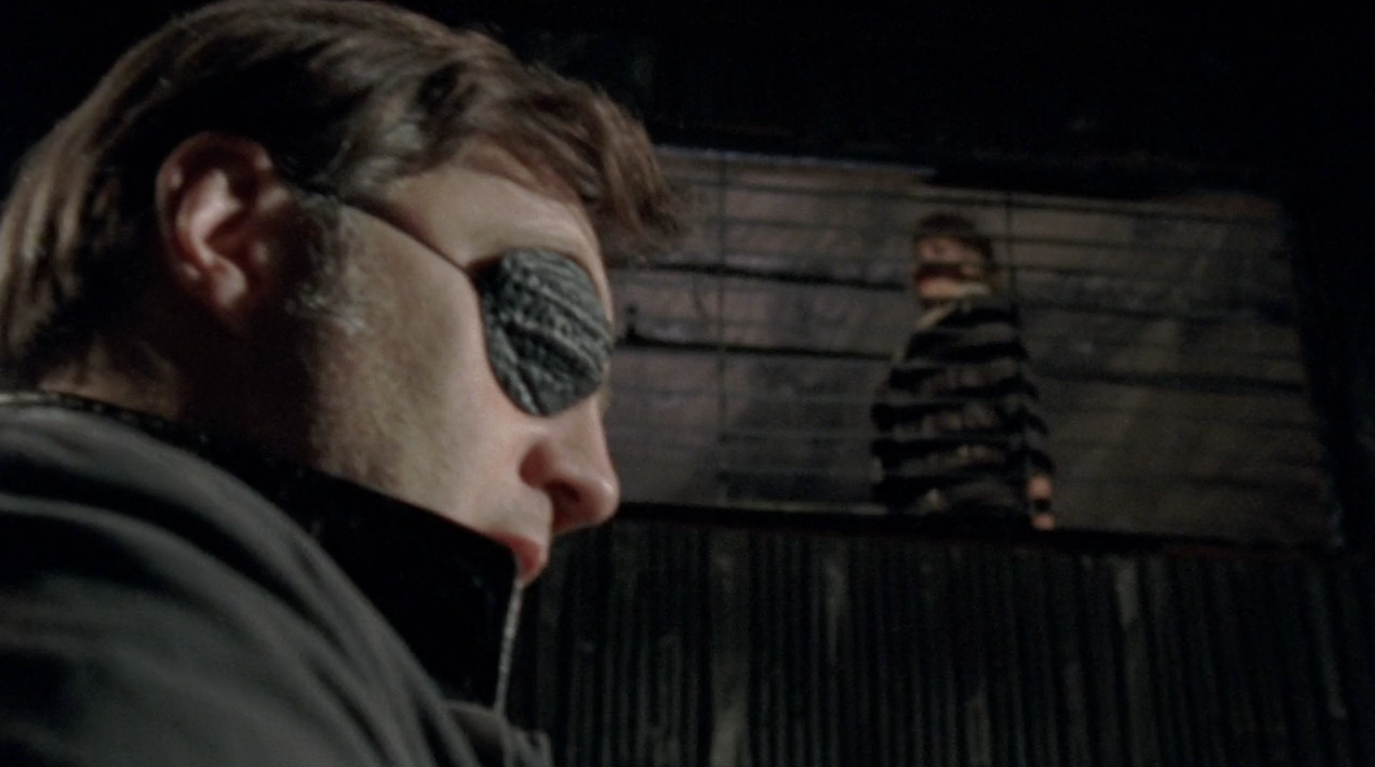
This is incredibly stupid since the Governor could look up and see her at any moment, and it’s surprising because it’s so phenomenally stupid, but it’s exactly what Andrea would really do in that moment – she’s much braver than most people, is not afraid of confrontation, and is incredibly curious, especially about the Governor, so it makes sense that she would stay in the open where she can see what he is doing, even though that means she’s also in danger of being seen by him. That scene is incredibly suspenseful and would have been much less so if Andrea had ducked out of sight like Milton did.
The Takeaway: If a scene needs more tension, maybe somebody needs to screw up – just make sure they’re screwing up in a way that is both surprising and yet also in character.
I’m Ready for My Close Up
Next time you watch this show (or any scary movie), notice how often the camera crops close on a character’s face during a tense scene. This serves two purposes:
(1) it zooms in on the character’s facial expression (usually fear or tension), which heightens our emotional response as we naturally empathize with the character, and
(2) it restricts our view of the character’s surroundings.
This second part is important. All we can see is the character’s face and maybe a sliver of out of focus background, but what we want to see is the place the character is in – is there something behind them? Is there something around the corner ahead of them? Look out, look out, look out!
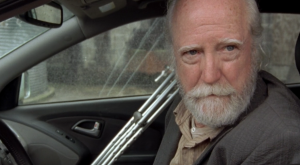
This is a directorial choice but it’s something we can do as writers as well. It’s basically a tactic of withholding information when we know the audience is very anxious to get that information as soon as possible. Maybe more on that in a future post.
The Takeaway: Withholding information can make an already tense scene even more suspenseful. Think about how you can do this with your writing (and look forward to a future post on the topic).
***
You can now like this page on Facebook! Click the “Following” dropdown and select “See First” and “Notifications On” to get notified of new posts.
